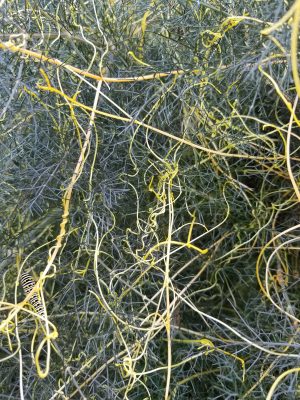Why do yucca trunks break in half?
Kim Schmider has a large Yucca torreyi that had three tall, individual trunks. This summer one of the trunks broke in half and was wet inside. Then, another trunk broke in half and sounded hollow. What’s going on?
We reached out to New Mexico landscape architect David Cristiani, and John White, Garden Curator for the Chihuahuan Desert Gardens at the University of Texas- El Paso, to get their thoughts. Both have seen this issue on torreyi and other large, tree-form yuccas.
Although it isn’t obvious from these photos, both John and David suggest the culprit could be yucca weevil. Look for frass and exit holes in the trunk. Also look for any cavities or trails that may have been made by other boring insects, whose larvae bore into the trunk and feed on the heart of the plant, making it less stable and more susceptible to decay and breakage.
John and David also noted, and I’ve witnessed this myself, that the problem could just as easily be that the weight of a large limb growing at an angle may become too heavy for the trunk to support. Environmental factors will have an effect on this: heavy spring rains in Central Texas may lead to rapid, weak growth. Also, in an irrigated landscape, regular irrigation, and perhaps fertilization, may be a factor causing the yucca to grow too fast.
In either case, rapid growth often results in a weakened trunk. Much like a teenager who may be a little clumsy at a point when their legs grow a little faster than the rest of their body, rapid growth spurts in desert species, which are more accustomed to a different pattern of rainfall, often become gangly and “lose their balance.”
Yucca are slow-growers, so resist the temptation to fertilize, and even to irrigate, except during the hottest, longest of dry spells, and even then, only sparingly. Plant yucca and other desert species in rocky areas of the garden, perhaps even on berms, and be sure that the soil has good drainage. And don’t use bark or other organic mulch around these plants. In short: do everything you can to mimic their native habitat.

